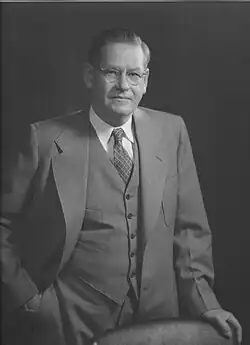Stanley Platt Lovell
Stanley Platt Lovell | |
|---|---|
 | |
| Chief of the Research and Development Branch, Office of Strategic Services | |
| In office 1942–1945 | |
| Appointed by | William J. Donovan |
| Succeeded by | Office of Technical Services |
| Personal details | |
| Born | August 29, 1890 Massachusetts, USA |
| Died | January 4, 1976 (aged 85) Massachusetts |
| Resting place | Hillside Cemetery Osterville, Barnstable County, Massachusetts, USA |
| Alma mater | Cornell University |
| Military service | |
| Branch/service | Office of Strategic Services |
| Rank | Chief |
| Battles/wars | World War II |
Stanley Platt Lovell was an American industrial biochemist and intelligence officer who headed the Research and Development Branch (R&D) of the Office of Strategic Services (OSS) during World War II, commonly referred to as the "Department of Dirty Tricks."[1][2]
Before the war began, Lovell already held over 70 patents.[1] In 1943, he was tapped by William J. Donovan to head the R&D Branch.[1] As head of R&D, he was in charge of many innovations developed by OSS during the war, leading a team of scientists to create some of the most bizare inventions during the war. As head of R&D, he is often thought to be an inspiration for the fictional character Q from the James Bond series, sharing this title with Charles Fraser-Smith from the British Special Operations Executive.[2] Smith and Lovell also collaborated on several devices. Lovell was the lead scientist in charge of the US Government's search for the "T-Drug," the first truth serum experiments undertaken by the US Intelligence Community, instructing George Hunter White to dose Americans with narcotics without their knowledge and to observe their behaviors.[3][4]
He and his team experimented with a way to kick the Nazis out of North Africa with mounds of manure and infected flies placed in rural villages.[5] The Hollywood actress Hedy Lamarr worked with Lovell for a time, inventing a distraction device that came to be known as "The Hedy." Lovell demonstrated The Hedy for the Joint Chiefs of Staff without advanced warning, and they never invited him back.[2] He is credited with the discovery that the Nazis were using heavy water in the process to construct a nuclear bomb.[6] He was one of the primary OSS chiefs responsible for the bat bomb experiments.[7] In 1944, Lovell approved the use of Nerve gas to be deployed on Iwo Jima, but the President vetoed this operation.[8] Lovell invented several devices for the potential assassination of Adolf Hitler, including a crushable tablet containing odorless mustard gas.[8] Lovell and his team invented the time pencil and the Limpet mine.[2] After the war, Lovell became President of the Lovell Chemical Company.
References
- ^ a b c Fischer, Benjamin (2007). "A History of the CIA's OTC" (PDF). CIA Reading Room.
- ^ a b c d Warwick, Mal (2023-04-19). "How the OSS waged secret warfare in World War II". Mal Warwick on Books: Insightful Reviews and Recommendations. Retrieved 2025-07-17.
- ^ McWilliams, John C. (1991). "Covert Connections: The FBN, the OSS, and the CIA". The Historian. 53 (4): 657–678. ISSN 0018-2370.
- ^ "Transforming Prince William Forest Park into Military Camps (U.S. National Park Service)". www.nps.gov. Retrieved 2025-07-17.
- ^ Korolev, Sergei (2016-09-04). "Evil WW2 Plots That Were Actually Pursued By The Good Guys". Cracked.com. Retrieved 2025-07-17.
- ^ "OSS Historical Structure". TPAAK. Retrieved 2025-07-17.
- ^ "Dr Stanley P Lovell, the OSS head of Research and Development". The Legend of Q. Retrieved 2025-07-17.
- ^ a b "(EST PUB DATE) FIFTY YEARS OF SUPPORTING OPERATIONS A HISTORY OF CIA'S OFFICE OF TECHNICAL SERVICE 1951-2001 | CIA FOIA (foia.cia.gov)". www.cia.gov. Retrieved 2025-07-17.